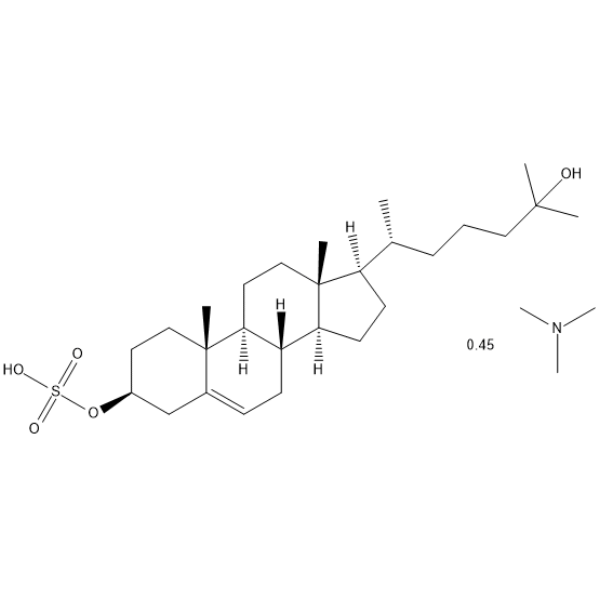Larsucosterol (trimethylamine) (Synonyms: DUR-928 (trimethylamine)) |
| Catalog No.GC65936 |
Larsucosterol (DUR-928) trimetilamina, un metabolito del colesterol, es un potente antagonista del receptor X del hÍgado (LXR). Larsucosterol trimetilamina como potente regulador endÓgeno disminuye la lipogénesis. Larsucosterol trimetilamina inhibe la biosÍntesis de colesterol al disminuir los niveles de ARNm e inhibir la activaciÓn de SREBP-1.
Products are for research use only. Not for human use. We do not sell to patients.

Sample solution is provided at 25 µL, 10mM.
Larsucosterol (DUR-928) trimethylamine, a cholesterol metabolite, is a potent liver X receptor (LXR) antagonist. Larsucosterol trimethylamine as a potent endogenous regulator decreases lipogenesis. Larsucosterol trimethylamine inhibits the cholesterol biosynthesis via decreasing mRNA levels and inhibiting the activation of SREBP-1[1][2][3].
Larsucosterol (DUR-928; 0-25 μM; 8 h; HepG2 cells) trimethylamine inhibits cholesterol biosynthesis by decreasing HMG-CoA reductase mRNA levels and decreases free [14C] cholesterol in a dose-dependent manner[1].
Larsucosterol (0-25 μM; 6 h; HepG2 cells) trimethylamine inhibits HMG-CoA reductase expression by inhibition of both SREBP1 activation and expression in hepatocytes[1].
Larsucosterol (0-50 μM; 48 h) trimethylamine increases cell proliferation and decreases apoptosis in macrophages[2].
Larsucosterol (0-25 μM; 48 h; macrophages) trimethylamine inhibits activation of liver oxysterol receptor LXRα[2].
Cell Proliferation Assay[2]
| Cell Line: | Macrophages |
| Concentration: | 0, 5, 10, 15, 20, and 25 μM |
| Incubation Time: | 48 hours |
| Result: | Induces cell proliferation and relative cell number after treatment for 48 h were 120% at 25 μM. |
Apoptosis Analysis[2]
| Cell Line: | Macrophages |
| Concentration: | 0, 10, 20, 30, 40 and 50 μM |
| Incubation Time: | 48 hours |
| Result: | Did not significantly affect the numbers of apoptotic or live cells. |
Western Blot Analysis[1]
| Cell Line: | HepG2 cells |
| Concentration: | 0, 3, 6, 12, and 25 μM |
| Incubation Time: | 6 hours |
| Result: | Inhibited the activation of SREBP-1 and SREBP-2, and subsequently inhibit the expression HMG-CoA reductase. |
Western Blot Analysis[2]
| Cell Line: | Macrophages |
| Concentration: | 0, 3, 6, 12, and 25 μM |
| Incubation Time: | 48 hours |
| Result: | Decreased LXRα levels in the nuclei in a does-dependent manner. |
Larsucosterol (DUR-928; 25 mg/kg; i.p.; twice in 14 hours; C57BL/6J mice with nonalcoholic fatty liver diseases (NAFLD) model) trimethylamine reduces serum lipid levels in mice fed a high-fat diet[3].
Larsucosterol (25 mg/kg; i.p.; twice in 14 hours; C57BL/6J mice with nonalcoholic fatty liver diseases (NAFLD) model) trimethylamine suppressed the expression of the genes and inhibits ABCA1 expressionde. Larsucosterolcreases nuclear SREBP-1 Protein levels and cytoplasmic FAS and ACC1 protein levels in liver tissue[3].
Larsucosterol (25 mg/kg; i.p.; once every 3 days for 6 weeks; C57BL/6J mice with nonalcoholic fatty liver diseases (NAFLD) model) trimethylamine protects the liver from injury by suppressing hepatic inflammation[3].
| Animal Model: | Female C57BL/6J mice with nonalcoholic fatty liver diseases (NAFLD) model[3] |
| Dosage: | 25 mg/kg |
| Administration: | Intraperitoneal injection; twice in 14 hours |
| Result: | Decreased plasma TG, CHOL, and HDL-C by 40, 15, and 20%, respectively. Reduced the mRNA levels of SREBP-1c, ACC1, and FAS by 46, 57, and 49%, respectively. Suppressed ABCA1 expression. Suppressed nuclear SREBP-1, cytoplasmic ACC1, and FAS protein levels by 74, 58, and 47%, respectively. |
| Animal Model: | Female C57BL/6J mice with nonalcoholic fatty liver diseases (NAFLD) model[3] |
| Dosage: | 25 mg/kg |
| Administration: | Intraperitoneal injection; once every 3 days for 6 weeks |
| Result: | Decreased plasma cholesterol levels. Reduced serum alkaline phosphatase, ALT, and AST levels. |
Average Rating: 5 (Based on Reviews and 30 reference(s) in Google Scholar.)
GLPBIO products are for RESEARCH USE ONLY. Please make sure your review or question is research based.
Required fields are marked with *




















